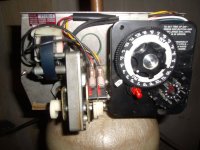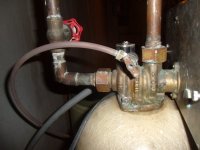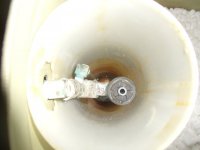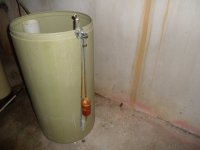I bought a home with a fleck water softener with either a 2500 or 2750 head and either a 3200 or 3210 timer. It doesn't have a brine valve, just a hose going to the salt tank. I'm trying to make adjustments to improve water quality and wondered if not having a brine valve could be causing a problem and are there specific changes i need to make to compensate for the lack of a brine valve. any ideas?
You are using an out of date browser. It may not display this or other websites correctly.
You should upgrade or use an alternative browser.
You should upgrade or use an alternative browser.
Fleck 2500/2750?
- Thread starter dozie94
- Start date
Users who are viewing this thread
Total: 2 (members: 0, guests: 2)
There are two valves commonly used in a brine tank. One is the air check valve that shuts off when the brine has been sucked out. It keeps air from being sucked in. You need an air check valve. On my Autotrol controller, that is actually part of the controller, so I just have a tube. I had not heard that any Fleck valves have air check valves built into the controller, but it is possible I guess.It doesn't have a brine valve, just a hose going to the salt tank.
The other is a safety float valve. That keeps the brine tank from overflowing in the event of a valve malfunction that happens to keep the brine fill cycle going. It also would guard against a power failure during the brine fill, although since the well pump would go off too, there is a limit to how much water would be available in that case. I don't have a safety float valve either. This is in a basement, so the damage would be limited compared to a brine tank in some other space. I'm keeping an eye out for a cheap used brine tank that has one. But also, my softener may not last forever, so I would get a new brine tank with safety float valve with a new system.
Sponsor
Paid Advertisement
It does have a safety float valve in the brine tank. Do I need to adjust that so there is enough water in the brine tank to complete the brine cycle?There are two valves commonly used in a brine tank. One is the air check valve that shuts off when the brine has been sucked out. It keeps air from being sucked in. You need an air check valve. On my Autotrol controller, that is actually part of the controller, so I just have a tube. I had not heard that any Fleck valves have air check valves built into the controller, but it is possible I guess.
The other is a safety float valve. That keeps the brine tank from overflowing in the event of a valve malfunction that happens to keep the brine fill cycle going. It also would guard against a power failure during the brine fill, although since the well pump would go off too, there is a limit to how much water would be available in that case. I don't have a safety float valve either. This is in a basement, so the damage would be limited compared to a brine tank in some other space. I'm keeping an eye out for a cheap used brine tank that has one. But also, my softener may not last forever, so I would get a new brine tank with safety float valve with a new system.
Bannerman
Well-Known Member
The hose will be connected to something. Care to post some photos?It doesn't have a brine valve, just a hose going to the salt tank.
Edit: Is this the assembly used?
http://www.softenerparts.com/v/vspfiles/assets/images/1600seriesbrine.jpg
Last edited:
I guess I did not understand what you were referring to as a brine valve.I bought a home with a fleck water softener with either a 2500 or 2750 head and either a 3200 or 3210 timer. It doesn't have a brine valve, just a hose going to the salt tank. I'm trying to make adjustments to improve water quality and wondered if not having a brine valve could be causing a problem and are there specific changes i need to make to compensate for the lack of a brine valve. any ideas?
What change are you trying to make? Are you looking for controlling how much water gets injected during the brine fill process? If so, there are 2 things. The BLFC controls the rate of flow, and a pin setting controls how long the water is injected during the brine fill (Length Of Brine Tank Refill Time). http://waterpurification.pentair.co...ItemDownload/en/2510-service-manual-40097.pdf page 5 talks about the pins.
It has the part labeled air check assembly on the diagram but the float is attached to that. When one of my kids get home I'll have them put a couple pictures on here. I think it will make more sense. If you haven't guessed I'm not real computer savvy.The hose will be connected to something. Care to post some photos?
Edit: Is this the assembly used?
http://www.softenerparts.com/v/vspfiles/assets/images/1600seriesbrine.jpg
Bannerman
Well-Known Member
Here's a link to the 2500 Power Head detail. http://www.softenerparts.com/v/vspfiles/assets/images/2500pwrhead.jpg
It appears brine valve piston #17 (shown in the prior linked 1600 brine assembly detail), is activated by cam # 23 located in the lower section of the power head. The brine valve is then held in-place by bracket #22.
It appears brine valve piston #17 (shown in the prior linked 1600 brine assembly detail), is activated by cam # 23 located in the lower section of the power head. The brine valve is then held in-place by bracket #22.
Last edited:
This is what i have. the last pic shows the float out of the brine tank. the softener has new seals and piston and resin was replaced 6 months ago. i'm getting a test kit but i know water is still hard. trying to figure what adjustments to make. I've never had a set up like this and i'm not sure how to make adjustments. thanks for all your help so far!Here's a link to the 2500 Power Head detail. http://www.softenerparts.com/v/vspfiles/assets/images/2500pwrhead.jpg
It appears brine valve piston #17 (shown in the prior linked 1600 brine assembly detail), is activated by cam # 23 located in the lower section of the power head. The brine valve is then held in-place by bracket #22.
Attachments
Last edited:
Before making adjustments, you want to see what it does. If there is not salt in the brine tank, I would start by adding a bag (~40 pounds) of salt into the brine tank, and 5 gallons of water. Record how high 5 gallons raises the water level. Let it sit for 3 hours or more. Then trigger a regeneration. I would not put much salt in while you are still testing.This is what i have. the last pic shows the float out of the brine tank. the softener has new seals and piston and resin was replaced 6 months ago. i'm getting a test kit but i know water is still hard. trying to figure what adjustments to make. I've never had a set up like this and i'm not sure how to make adjustments. thanks for all your help so far!
Watch the regeneration cycle. The brine should get sucked down. Then later the water level should rise some during the fill step.
Does the water get softer after that regen? Try the cold water with soap before and after. It takes a while to replace the water in the water heater, so testing that will not give a quick result.
How big is your mineral tank: height and either diameter or circumference?
Last edited:
There's plenty of salt in the brine tank. when it regenerates its drawing the brine but i'm not sure how low the water level should get in the tank and when it fills how high it should get. I want to watch it run it through the entire regeneration cycle and be sure its doing it properly and the correct amount of time. I don't know if the lack of a brine valve and BLFC could be causing a problem. that's why i want to be sure of the correct levels in the brine tank. mineral tank is 4 foot x 32 inches (diameter).Before making adjustments, you want to see what it does. If there is not salt in the brine tank, I would start by adding a bag (~40 pounds) of salt into the brine tank, and 5 gallons of water. Record how high 5 gallons raises the water level. Let it sit for 3 hours or more. Then trigger a regeneration. I would not put much salt in while you are still testing.
Watch the regeneration cycle. The brine should get sucked down. Then later the water level should rise some during the fill step.
Does the water get softer after that regen? Try the cold water with soap before and after. It takes a while to replace the water in the water heater, so testing that will not give a quick result.
How big is your mineral tank: height and either diameter or circumference?
We still don't know what your original question was about.
The mineral tank is the tank with the resin and the controller on top.
Your 32 inch diameter brine tank is unusually large.
If there were no salt above the water, 5 gallons would be expected to raise the water level by 1.44 inches. With salt above the waterline , the rise for 5 gallons of water would be about 3.6 inches before the salt dissolves into the new water.
Your 32 inch diameter brine tank is unusually large.
If there were no salt above the water, 5 gallons would be expected to raise the water level by 1.44 inches. With salt above the waterline , the rise for 5 gallons of water would be about 3.6 inches before the salt dissolves into the new water.
Last edited:
Bannerman
Well-Known Member
Looking at both the 2500 and 2750 info, as the brine valve is a separate component, I think someone either removed the brine valve or incompletely converted a back-washing valve to softener duty.
http://www.lakesidewater.com/docs/2750-service-manaul-downflow-42327-rev-c.pdf
Your controller face-on photo seems to show a brine cam (white disk) on the lower left. Looking at the rear side of the controller, I only see what appears to be some bolts where the brine valve should be located.
https://terrylove.com/forums/index.php?attachments/softener-head-rear-compressed-jpg.17114/
Your brine tube was connected directly to the injector with no method to control the brine fill volume other than adjusting the safety float to set the brine fill height. The actual brine volume will vary even if the height remains consistent, depending on the type and amount of salt remaining.
Another option: the small manual valve installed into the side of the injector, maybe acting as a makeshift BLFC, with the timer pins controlling the fill time.
Suggest making inquiries to establish if the appropriate brine valve remains available. The brine valve incorporates a BLFC.
The brine tank liquid will be drawn-out until the air check closes, so there will not be much liquid remaining.
The fill volume is controlled by the BLFC, brine valve and fill time programmed. The fill volume determines the amount of salt that is dissolved (3 lbs/gal) which then determines the amount of softening capacity that will be restored.
http://www.lakesidewater.com/docs/2750-service-manaul-downflow-42327-rev-c.pdf
Your controller face-on photo seems to show a brine cam (white disk) on the lower left. Looking at the rear side of the controller, I only see what appears to be some bolts where the brine valve should be located.
https://terrylove.com/forums/index.php?attachments/softener-head-rear-compressed-jpg.17114/
Your brine tube was connected directly to the injector with no method to control the brine fill volume other than adjusting the safety float to set the brine fill height. The actual brine volume will vary even if the height remains consistent, depending on the type and amount of salt remaining.
Another option: the small manual valve installed into the side of the injector, maybe acting as a makeshift BLFC, with the timer pins controlling the fill time.
Suggest making inquiries to establish if the appropriate brine valve remains available. The brine valve incorporates a BLFC.
i'm not sure how low the water level should get in the tank and when it fills how high it should get.
The brine tank liquid will be drawn-out until the air check closes, so there will not be much liquid remaining.
The fill volume is controlled by the BLFC, brine valve and fill time programmed. The fill volume determines the amount of salt that is dissolved (3 lbs/gal) which then determines the amount of softening capacity that will be restored.
Last edited:
ditttohead
Water systems designer, R&D
That is a very old design. No brine valve on the valve even though it has the brine cam.
The old brass brine valve in the brine tank was not intended for brine tank controlling. It was designed as a safety but many companies used it as a valve. I don't have muy charts with me but I will in a few dsys. In general the salt displaces 50% of the water.this is highly inaccurate and is why timed refill systems are far more accurate than float resulted systems.
Are you sure about the brine tank size?
Below are estimates
18" diameter tank 1.2 pound salt per inch of water
24" diameter tank 2 pounds salt per inch of water
30" diameter tank 3.2 pounds salt per inch of water.
Obviously the type of salt and displacement etc. Are unknown variables.
Hope this helps.
The old brass brine valve in the brine tank was not intended for brine tank controlling. It was designed as a safety but many companies used it as a valve. I don't have muy charts with me but I will in a few dsys. In general the salt displaces 50% of the water.this is highly inaccurate and is why timed refill systems are far more accurate than float resulted systems.
Are you sure about the brine tank size?
Below are estimates
18" diameter tank 1.2 pound salt per inch of water
24" diameter tank 2 pounds salt per inch of water
30" diameter tank 3.2 pounds salt per inch of water.
Obviously the type of salt and displacement etc. Are unknown variables.
Hope this helps.
Now I finally get it. Thanks.That is a very old design. No brine valve on the valve even though it has the brine cam.
H2O Services
Water Treatment Specialist
Have you cleaned out the brine tank to make sure it is not full of sludge. This will cause short brining. The brine refill is controlled (On a 2500) by the pin settings on the back of the cam assembly. The resin may be iron fouled and there may very well have been resin lost over the years from breaking down. Clean the eductor assembly and set it to run every day for a week to see if the water quality improves. Then you can taper the regens back to 2-3 days depending on your usage/water chemistry.Now I finally get it. Thanks.
Similar threads
- Replies
- 3
- Views
- 598
- Replies
- 0
- Views
- 340
- Replies
- 0
- Views
- 415
- Replies
- 1
- Views
- 318




